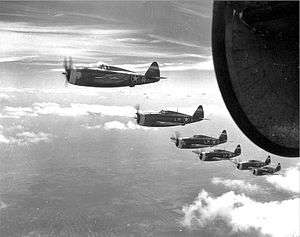Pointblank directive
| Combined Bomber Offensive | |||||||
|---|---|---|---|---|---|---|---|
| Part of Strategic bombing campaign in Europe | |||||||
 USAAF P-47 Thunderbolt fighters, assigned to protect 8th Air Force bomber formations and to hunt for German fighters. | |||||||
| |||||||
| Belligerents | |||||||
|
|
| ||||||
| Commanders and leaders | |||||||
| Arthur Harris, Carl Spaatz | |||||||
The Pointblank directive authorised the initiation of Operation Pointblank, the code name for the primary portion[2] of the Allied Combined Bomber Offensive intended to cripple or destroy the German aircraft fighter strength, thus drawing it away from frontline operations and ensuring it would not be an obstacle to the invasion of Northwest Europe. The Pointblank directive of 14 June 1943 ordered RAF Bomber Command and the U.S. Eighth Air Force to bomb specific targets such as aircraft factories, and the order was confirmed when the Allies met at the Quebec Conference, 1943.
Up to that point the RAF and USAAF had mostly been attacking German industry in their own way – the British by broad night attacks on industrial areas and the US in "precision attacks" by day on specific targets. The operational execution of the Directive was left to the commanders of the forces and as such even after the directive the British continued in night attacks and the majority of the attacks on German fighter production and combat with the fighters was down to the USAAF.[3][4]
In practice the USAAF bombers made large scale daylight attacks on factories involved in the production of fighter aircraft. The Luftwaffe was forced into defending against these raids, and its fighters were drawn into battle with the bombers and their escorts. It was these battles of attrition that reduced the Luftwaffe strength despite increases in German aircraft production.[5]
Casablanca directive

At the January 1943 Casablanca Conference, the Combined Chiefs of Staff agreed to conduct the Combined Bomber Offensive (CBO), and the British Air Ministry issued the Casablanca directive on 4 February with the object of:
"The progressive destruction and dislocation of the German military, industrial and economic systems and the undermining of the morale of the German people to a point where their capacity for armed resistance is fatally weakened. Every opportunity to be taken to attack Germany by day to destroy objectives that are unsuitable for night attack, to sustain continuous pressure on German morale, to impose heavy losses on German day fighter force and to conserve German fighter force away from the Russian and Mediterranean theatres of war".[6]
On 14 June 1943, the Combined Chiefs of Staff issued the Pointblank directive which modified the February 1943 Casablanca directive.[7] Along with the single-engine fighters of the CBO plan,[7] the highest priority Pointblank targets were the fighter aircraft factories since the Western Allied invasion of France could not take place without fighter superiority. In August 1943, the Quebec Conference upheld this change of priorities.[8][9]
Among the factories listed were the Regensburg Messerschmitt factory (which would be attacked at high cost in August), the Schweinfurter Kugellagerwerke ball-bearing factory (attacked in October and also causing heavy USAAF losses) and the Wiener Neustädter Flugzeugwerke (WNF) which produced Bf 109 fighters.
Notes
- Notes
- Citations
- ↑ Gruen, pp. 4(Round 1),5(Round 2) 24.
- ↑ Emerson 1962, p. 4.
- ↑ Varley 2005, p. 32.
- ↑ Zaloga 2011, p. 12.
- ↑ Zaloga 2011, p. 85.
- ↑ Harris & Cox 1995, p. 196.
- 1 2 Darling, p. 181
- ↑ Valour and Horror staff 2005 cites "Strategic air offensives", The Oxford Companion to World War II
- ↑ Delleman 1995–1998.
References
- Darling, Kev, Aircraft of the 8th Army Air Force 1942-1945, Lulu.com, p. 181, ISBN 978-0-9559840-0-6
- Delleman, Paul (1995–1998), "LeMay and Harris the "Objective" Exemplified", Air & Space Power Journal, Chronicles Online Journal, retrieved 2008-07-14
- Emerson, William R. (1962), "Operation POINTBLANK: A Tale of Bombers and Fighters", USAFA Harmon Memorial Lecture, archived from the original on 25 March 2008
- Harris, Arthur Travers; Cox, Sebastian (1995), Despatch on War Operations: 23 February 1942, to 8 May 1945, Routledge, p. 196, ISBN 0-7146-4692-X
- Kreis, John F.; Cochran, Jr., Alexander S.; Ehrhart, Robert C.; Fabyanic, Thomas A.; Futrell, Robert F.; Williamson, Murray (1996). Piercing the Fog: Intelligence and Army Air Forces Operations in World War II. Washington, D.C.: Air Force Historical Studies Office. p. 241. ISBN 978-1-4289-1405-6.
- Gruen, Adam L, "Preemptive Defense, Allied Air Power Versus Hitler's V-Weapons, 1943–1945", The U.S. Army Air Forces in World War II, pp. 4(Round 1),5(Round 2), retrieved 2007-05-07
- Varley, Michael (2005), "17 Operation Pointblank" (PDF), Aspects of the Combined British and American Strategic Air Offensive against Germany 1939 to 1945 (subsequently extensively revised ed.), p. 32, retrieved August 2012 Check date values in:
|access-date=(help) - Zaloga, Steven J. (2011), Operation Pointblank 1944; Defeating the Luftwaffe, Osprey Campaign Series #236, Osprey Publishing, ISBN 978-1-84908-385-0
- Valour and Horror staff (20 December 2005), Background: Combined Bomber - World War Two, Valour and Horror, archived from the original on 20 December 2005, retrieved August 2012 Check date values in:
|access-date=(help)
Further reading
- Hansell, Haywood S. (Jr) (1972). The Air Plan That Defeated Hitler. Atlanta: Higgins-McArthur/Longino and Porter. ISBN 0-405-12178-4. Retrieved 2007-01-17.
- Harris, Arthur Travers (2005). Bomber Offensive. Pen & Sword. ISBN 1-84415-210-3.